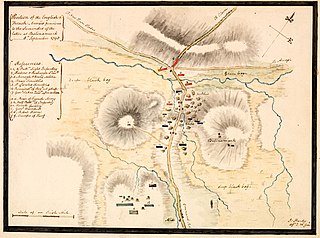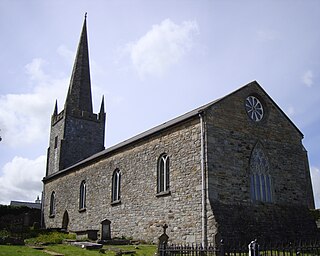
Castlebar is the county town of County Mayo, Ireland. Developing around a 13th-century castle of the de Barry family, from which the town got its name, the town now acts as a social and economic focal point for the surrounding hinterland. With a population of 13,054 in the 2022 census, Castlebar was one of the fastest growing towns in Ireland in the early 21st century.

Ballycastle is a village in County Mayo, Ireland, situated northwest from Ballina, near Mayo's north coast. It lies on the edge of the Mayo Gaeltacht.

The Battle of Castlebar was a military engagement of the Irish Rebellion of 1798 which occurred on 27 August 1798 near the town of Castlebar, County Mayo. A combined force of 2,000 French Revolutionary Army troops and United Irishmen rebels routed a British Crown force of 6,000 men mainly consisting of Irish militiamen by Gerard Lake, 1st Viscount Lake in what would later become known as the "Castlebar Races" or "Races of Castlebar".

General Jean Joseph Amable Humbert was a French military officer who participated in several notable military conflicts of the late 18th and early 19th century. Born in the townland of La Coâre Saint-Nabord, outside Remiremont Vosges, he was a sergeant in the National Guard of Lyon. He rapidly advanced through the ranks to become brigadier general on 9 April 1794 and fought in the Western campaigns before being allocated to the Army of the Rhine. Humbert also participated in the United Irishman Rebellion and the War of 1812.

The Battle of Ballinamuck marked the defeat of the main force of the French incursion during the 1798 Rebellion in Ireland.

The Bishop of Killala is an episcopal title which takes its name after the village of Killala in County Mayo, Ireland. In the Roman Catholic Church it remains a separate title, but in the Church of Ireland it has been united with other bishoprics.

The Diocese of Killala is a Latin Church diocese of the Catholic Church in Connacht; the western province of Ireland. It is in the Metropolitan Province of Tuam and is subject to the Metropolitan Archdiocese of Tuam. As of 2024, the seat of the Diocese is “Sede Vacante” meaning there is no current permanent Bishop appointed for this Diocese
Thomas Anthony Finnegan was the Bishop of Killala, County Mayo, Ireland from 1987 to 2002.
Events from the year 1798 in Ireland.

The Diocese of Tuam, Killala and Achonry is a former diocese in the Church of Ireland located in Connacht; the western province of Ireland. It was in the ecclesiastical province of Armagh. Its geographical remit included County Mayo and part of counties Galway and Sligo. In 2022, the diocese was amalgamated into the Diocese of Tuam, Limerick and Killaloe.

St Muredach's College is an all-boys secondary school on the banks of the River Moy in Ballina, County Mayo, Ireland. It was founded in 1906 to provide a Catholic education for boys in the Killala Diocese. The school building, which was designed by William Henry Byrne, is included on the Record of Protected Structures maintained by Mayo County Council.

The Battle of Killala was an engagement during the Irish Rebellion of 1798. It was fought on Sunday, 23 September 1798, between forces of the British Crown and a combined force of Irish rebels and a small number of French troops at Killala, County Mayo, Ireland.
Henry O'Keane was an Irish catholic priest and French army officer.

St Muredach's Cathedral is the cathedral church of the Roman Catholic Diocese of Killala in Ireland. It is located on the east bank of the River Moy in Ballina, County Mayo. It is also the parish church of the parish of Kilmoremoy.

St Patrick's Cathedral, Killala is one of five cathedral churches in the Diocese of Tuam, Limerick and Killaloe of the Church of Ireland. It is situated on the Ballina to Ballycastle road in the small coastal village of Killala, County Mayo, Ireland. It is part of the ecclesiastical province of Dublin.
Fr. Brendan Hoban is an Irish Catholic priest in the Killala Diocese, columnist and author of a number of books. Fr. Hoban was born in Ballycastle, Co. Mayo in 1948. Educated in Ballycastle Boys National School, St Muredach¹s College, Ballina and entered St Patrick's College, Maynooth in 1966 and was ordained for the diocese of Killala in 1973. He writes a weekly column in the Western People.

Ballina is a town in north County Mayo, Ireland. It lies at the mouth of the River Moy near Killala Bay, in the Moy valley and Parish of Kilmoremoy, with the Ox Mountains to the east and the Nephin Beg mountains to the west. The town occupies two baronies; Tirawley on the west bank of the Moy River, and Tireragh, a barony within County Sligo, on its east banks. At the 2022 census, the population of Ballina was 10,556.
Patrick O'Boyle was an Irish prelate who served as Bishop of Killala.

The Diocese of Tuam, Limerick and Killaloe is a diocese of the Church of Ireland that is located in the west of Ireland. The diocese was formed by a merger of the former Diocese of Tuam, Killala and Achonry and the former Diocese of Limerick and Killaloe in 2022, after the retirement of the separate dioceses' bishops and the appointment of Michael Burrows as bishop of the united diocese. It is in the ecclesiastical province of Dublin. It is one of the eleven Church of Ireland dioceses that cover the whole of Ireland. The largest diocese by area in the Church of Ireland, it covers all of counties Clare, Galway, Kerry, Limerick and Mayo, plus parts of counties Cork, Sligo, Roscommon, Offaly, Laois and Tipperary.
















